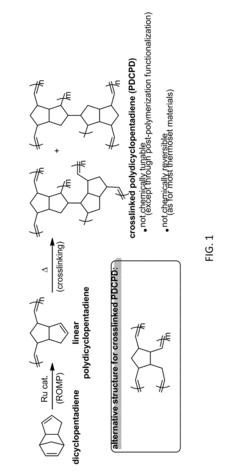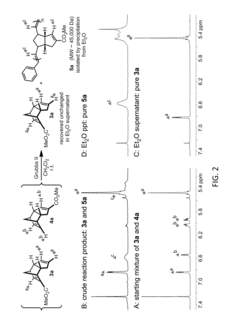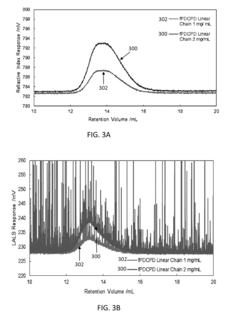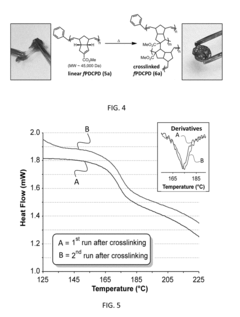Research on crosslinking and branching modifications for polymers - Eureka
OCT 8, 20244 MIN READ
Generate Your Technical Report in Patsnap Eureka
AI-Powered Innovation Solution Platform for R&D
Crosslinking and Branching in Polymers: Background and Goals
The primary objective is to provide a comprehensive overview of the development history and evolution trends in the field of polymer crosslinking and branching modifications. This includes tracing the key milestones and breakthroughs that have shaped the progress of this technology over time. Additionally, it aims to clearly define the expected technological goals and advancements that researchers and industry players are striving to achieve through further advancements in this domain.
By establishing a solid understanding of the technology's background and aspirations, this section lays the foundation for the subsequent analysis and exploration of market demands, current technological landscape, potential innovation pathways, and strategic recommendations within the broader context of the research report.
By establishing a solid understanding of the technology's background and aspirations, this section lays the foundation for the subsequent analysis and exploration of market demands, current technological landscape, potential innovation pathways, and strategic recommendations within the broader context of the research report.
Market Demand for Modified Polymers
- Growing Demand for Modified Polymers
The market for modified polymers is expanding rapidly due to their enhanced properties and versatility in various applications, including packaging, construction, automotive, and electronics. - Improved Performance and Functionality
Crosslinked and branched polymers offer superior mechanical strength, thermal stability, chemical resistance, and barrier properties compared to their linear counterparts, driving demand across industries. - Sustainability and Environmental Concerns
The need for eco-friendly and recyclable materials is fueling the demand for modified polymers that can meet stringent environmental regulations and reduce waste. - Emerging Applications
Novel applications in fields like biomedical, energy storage, and advanced composites are creating new market opportunities for specialized modified polymers with tailored properties. - Market Segmentation and Growth Potential
The market for modified polymers is segmented based on polymer type, modification method, and end-use industry, with each segment exhibiting unique growth prospects and market dynamics.
Current State and Challenges in Polymer Modifications
- Polymer Modification Challenges
- Controlling reaction conditions for uniform modifications
- Achieving desired degree of crosslinking or branching
- Maintaining polymer properties after modifications
- Technical Bottlenecks
- Limited understanding of reaction mechanisms
- Lack of precise control over reaction pathways
- Difficulty in characterizing modified polymer structures
- Geographical Distribution
- Major research centers in North America, Europe, and Asia
- Concentration of expertise in academic institutions and R&D labs
- Emerging research hubs in developing countries
Evolution of Crosslinking and Branching Techniques

Existing Solutions for Polymer Crosslinking and Branching
01 Crosslinking Agents and Methods
Various crosslinking agents and methods for crosslinking polymers to improve their properties, including triazines, dihydroxyacetone, branching agents, electron beam crosslinking, and chemical crosslinking.- Crosslinking Agents and Methods: Various crosslinking agents and techniques for crosslinking polymers to enhance their properties, including triazines, dihydroxyacetone, branching agents, electron beam crosslinking, and chemical crosslinking.
- Branched Polymer Synthesis and Characterization: Methods for synthesizing branched polymers and characterizing their branching structure, such as computational processes for determining composition and sequence, techniques for measuring short-chain branching, and controlling long-chain branching.
- Crosslinked Polymer Compositions and Applications: Crosslinked polymer compositions and their applications, including shape memory materials, ion exchange resins, barrier blends, and cable insulation, exhibiting improved properties due to crosslinking.
- Polymer Modification through Branching and Crosslinking: Methods for modifying polymer properties through branching and crosslinking processes, such as introducing branching agents, controlling molecular weight distribution, and modifying flow properties and resin values.
- Surface Crosslinking and Crosslinked Polymer Particles: Processes for surface crosslinking polymer particles, like water-absorbent particles, and producing crosslinked polymer particles with improved properties through techniques like blowing agents and cooling.
02 Branched Polymer Synthesis and Characterization
Methods for synthesizing branched polymers and characterizing their branching structure, including computational processes for determining composition and sequence, techniques for measuring short-chain branching, and controlling long-chain branching.03 Crosslinked Polymer Compositions and Applications
Various crosslinked polymer compositions and applications, such as crosslinked polymer beads for ion exchange resins, crosslinked polyurethane acrylate resins, and crosslinked polymers for cable insulation and water-absorbent materials.04 Polymer Property Modification through Crosslinking and Branching
Techniques for modifying polymer properties like flow properties, resin properties, and molecular weight distribution through crosslinking and branching processes, including methods for controlling continuous polymerization reactions and reducing out-of-specification polymers.05 Crosslinked Polymer Materials and Applications
Various crosslinked polymer materials and their applications, including elastomeric materials with covalent and non-covalent crosslinking, fluorescent polymer dots with enhanced properties through chemical crosslinking, and biodegradable polymer composites with water crosslinking properties.
Key Players in Polymer Modification Industry
The competitive landscape for crosslinking and branching modifications for polymers is characterized by a mix of industry leaders and academic institutions. The industry is in a mature stage with significant market size, driven by applications in various sectors such as automotive, healthcare, and construction. Companies like BASF AB, Dow Silicones Corp., and DuPont de Nemours, Inc. are at the forefront, showcasing high technical maturity. Academic institutions such as Zhejiang University and Monash University contribute to ongoing research and innovation. The collaboration between industry and academia is crucial for advancing this technology and maintaining competitive advantage.
Hangzhou Xinglu Technology Co Ltd
Technical Solution:
China Petroleum & Chemical Corp.
Technical Solution: China Petroleum & Chemical Corp. has developed advanced crosslinking and branching techniques, focusing on enhancing mechanical properties and thermal stability using novel catalysts and crosslinking agents.
Strength: High mechanical properties and thermal stability. Weakness: Potentially higher production costs.
Core Innovations in Polymer Modification Techniques
Functionalized polydicyclopentadiene polymer
PatentActiveUS20180371128A1
Innovation
- Providing crosslinked polymers derived from linear polymers with reversible crosslinks
- Introducing functional groups on linear or crosslinked polymers through chemical or physical processes
- Utilizing the monomers, linear polymers or crosslinked polymers for various manufacturing processes
Environmental Impact of Polymer Modifications
Polymer crosslinking and branching modifications are crucial techniques for tailoring material properties and enhancing performance. Crosslinking involves forming covalent bonds between polymer chains, improving mechanical strength, thermal stability, and chemical resistance. Branching introduces side chains or grafts, impacting viscosity, processability, and physical properties. These modifications find applications in diverse fields like packaging, coatings, adhesives, and biomedical materials. Key challenges include controlling the degree of crosslinking/branching, achieving uniform distribution, and minimizing undesirable side reactions. Potential innovations involve exploring new crosslinking agents, branching strategies, and combined approaches for synergistic effects, enabling the design of advanced polymeric materials with tailored functionalities.
the structure of the environmentally friendly knitted fabric provided by the present invention; figure 2 Flow chart of the yarn wrapping machine for environmentally friendly knitted fabrics and storage devices; image 3 Is the parameter map of the yarn covering machine
Login to View More Regulatory Considerations for Modified Polymers
Polymer crosslinking and branching modifications are crucial techniques for enhancing material properties and tailoring polymers for specific applications. Crosslinking involves forming covalent bonds between polymer chains, increasing rigidity, thermal stability, and solvent resistance. Branching introduces side chains or grafts, impacting viscosity, processability, and mechanical strength. These modifications enable polymers to meet diverse requirements across industries like packaging, construction, and biomedical. Ongoing research explores novel crosslinking agents, controlled branching methods, and sustainable approaches to expand the versatility and performance of polymeric materials.
the structure of the environmentally friendly knitted fabric provided by the present invention; figure 2 Flow chart of the yarn wrapping machine for environmentally friendly knitted fabrics and storage devices; image 3 Is the parameter map of the yarn covering machine
Login to View More If you want an in-depth research or a technical report, you can always get what you want in Patsnap Eureka TechResearch . Try now!



